- Home
- Deceptions
- Solar
- Thermal Audit
- Ventilation
- Sensors
- Governance
- Environment
- Reference
- Contact
- News
Heating Public Infrastructure in
Newfoundland and Labrador
[Return to Policy Summary Page]
Heating is the largest utility cost for most public buildings and totally dwarfs lighting expenses. High efficiency heating systems, triple glazed windows and eliminating drafts by perhaps replacing the siding and doors are all great improvements, but they don't make economic sense unless certain basic things are taken care of first. It is like buying new energy star appliances to save on the electric bill for a house with a missing back door.
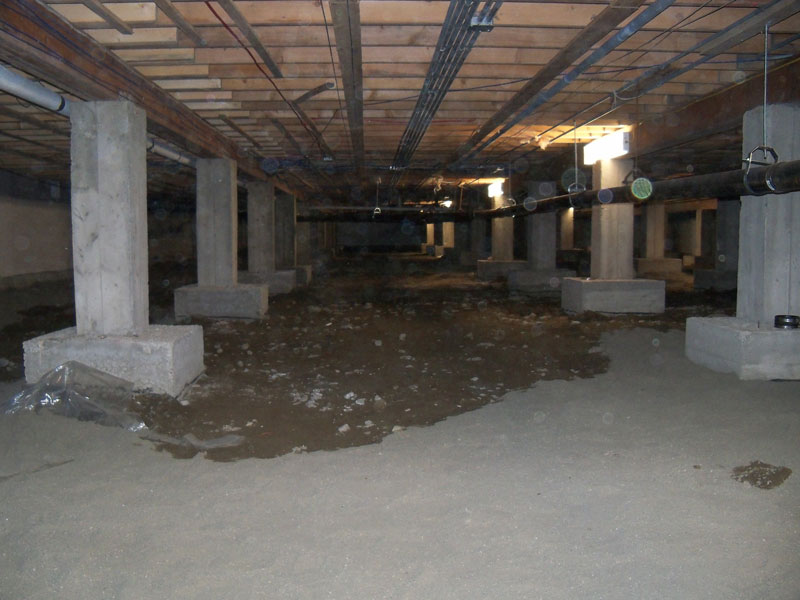
The picture above is a public building with completely un-insulated crawl space. The rooms above are about 20C while the space below is just above zero. This temperature difference and total lack of insulation guarantees a large heat flow through the floor and can add 30% to the heating bill. The water shown above is from a plumbing leak.
The picture below is even worse. Unlike the building above that has a concrete foot wall, this building is above ground and has a skirt of plywood. Cold winds in winter actually blow up the insides of interior walls. In this pathetic example, heating costs could probably be chopped in half with proper insulation. This photo of neglect is from 2002, and nothing has changed 11 years later. When it is -10C outside, it is also -10C in this crawl space.
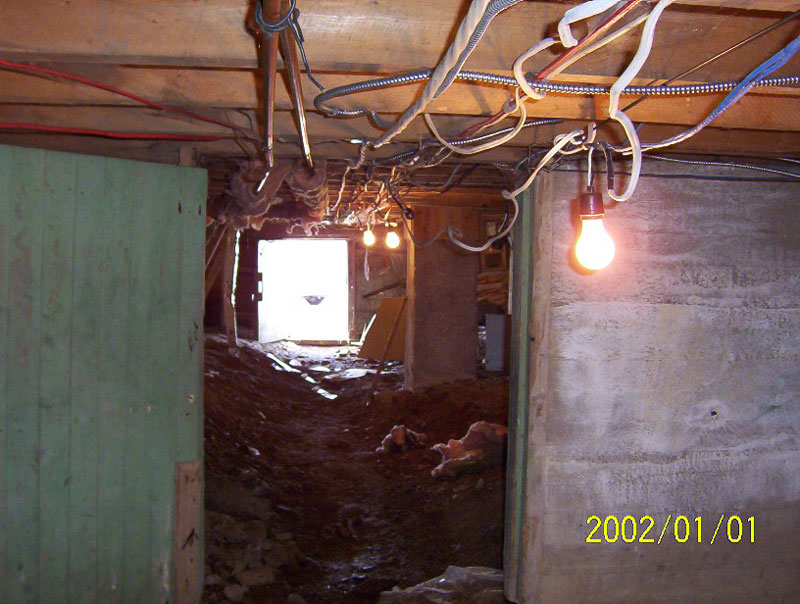
The photo below shows another un-insulated space outside of a cafeteria. The nasty stuff that looks like sewage, is just iron rich sludge. Humid levels are very high - perfect for molds.
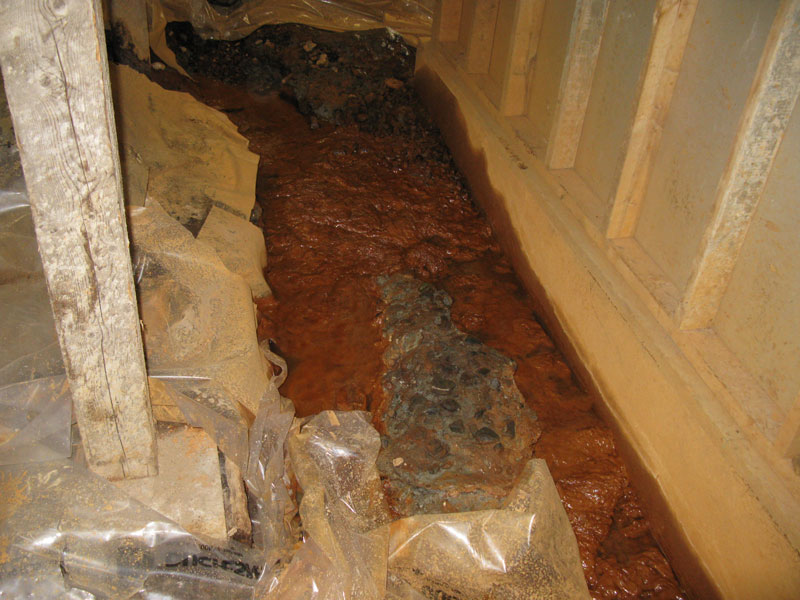
Just to the left of the picture above, is this abandoned and uncovered well. Children play here, and there are class murals on the wall behind the abandoned well. The dept. of environment would like to do a water sample and figure out where these wells are but has no money to do so. As a matter of policy, abandoned water wells should be filled in -- especially when they are found inside of schools.
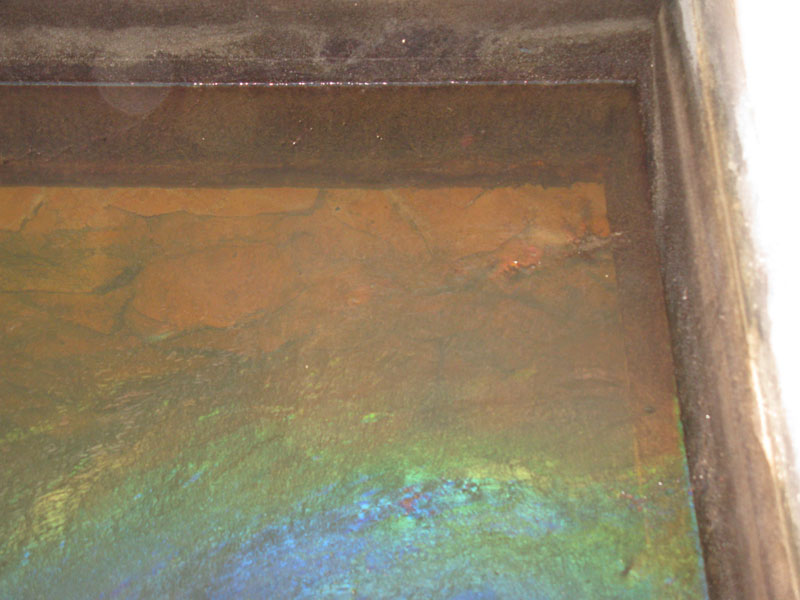
Step 1:
The department of transportation and works has the blueprints for all public buildings and can identify which ones have crawl spaces. Complete list here ... Each building with crawl spaces should be inspected by a small team of government engineers. This must be NOT be outsourced to engineering firms. An outsourced assessment can cost $10,000 yet could be completed and documented by staff engineers in two days. No government engineer makes this kind of money (salaries range from $60,000 to $80,000). As a matter of principle, all routine work should be done by public sector staff engineers and technicians. Outsourcing analysis here ...
Buildings should be grouped by region. For example, as soon as the public sector buildings in the Conaigre region are inspected, those with missing insulation should be prepared for an immediate tender. The tender package should include details as to insulation type, thickness (at least R20) and pipe insulation as needed. There may be a few cases where it is better to insulate the foot walls rather than the floor -- staff engineers can figure this out.
Once the first public tender is released, the inspection staff should continue on to another batch of buildings. In the list above, there are approximately 870 buildings. This is a lot of work -- more staff must be hired to save money, both on heating and in avoiding providing corporate welfare for the likes of SNC, BAE, Stantec and others that do not deserve $180/hr of taxpayer monies. It is not advisable to do all the inspections first before tendering insulation work because it will result in a multi year delay.
If 800 buildings are to be assessed in 5 years, this is 160 buildings a year. Obviously, some of these are new or large facilities like hospitals that look nothing like the photos above. Team up groups of engineers (once civil, one mechanical, one electrical) and assign them to three territories. Labrador, Grand Falls or Gander and St. John's. Each group needs a government vehicle and their mission is to identify the low hanging fruit first and get the upgrade work tendered. Since they will have made the investment in travel time to get out to remote locations like Ramea, it makes sense that they not only identify energy issues (to pay their salaries and generating savings for the province), but to perform assessments and document all interrelated issues -- sewage problems, ungrounded electrical systems, mold, asbestos, fire and life safety etc.
This would cost 9 full time engineers, 3 vehicles, $40,000 in equipment for each team (thermal imager, environmental test equipment, safety equipment etc.) and would eliminate many millions in consulting fees followed by millions in energy savings forever.
Once this insulation phase of the project is complete, the engineering teams can move on to heating source upgrades (geothermal, pellets, electric baseboard in some cases).
Step 2:
Publish the list of buildings above, but with extra columns for energy per square meter per heating degree day. An additional column should link to enviromental reports (asbestos and mold). This will allow the public to compare buildings across our vast region and expensive buildings will stand out and get the attention they deserve. It also presents project progress to the electorate.
Step 3:
Identify the buildings that have functional hot water heating systems. These are candidates for retrofit with air-to-water heat pumps (three times better than electric baseboard heat) and biomass stoves (wood pellets).
Consult with wood pellet industry groups to determine the tonnage of pellets needed for sufficient base demand to ensure the industry can grow, perhaps three companies initially. This base demand ensures that new manufacturers of pellets can develop residential customers over a few years without going out of business. It also means that government supply contracts must insist that the wood come from Newfoundland (tree thinning perhaps) and be harvested in sustainable ways. This may end up being a violation of international treaties signed by the Harper Regime. In this is the case, local government must implement a buy local policy anyway and fight back and defy them if necessary. Rebates on residential pellet stoves was tried successfully in Norway.
Let's say that this based demand requirement turns out to be a collection of 20 public buildings, then these would be converted to dual biomass / electric heat. The electric heat would be to keep them honest (no price gouging) and guard against a supply disruption. Dual heat sources would provide fault tolerance and versatility.
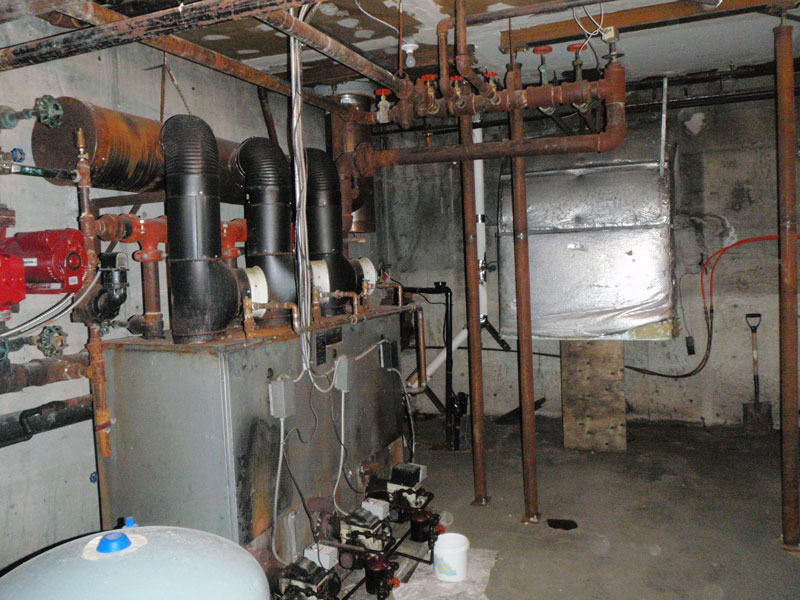
It may be hard to believe, but contraptions like the thing above live in asbestos lined furnace rooms all over Newfoundland and Labrador. It is time for them to retire. Unfortunately, the government has been gutting them and installing baseboard electric heat. This causes a number of problems, including:
- Baseboard heat is low efficiency (100%) compared to geothermal (300%). However, it is reliable.
- Once the piping is stripped out, it becomes cost prohibitive to re-install hot water based heat that could support geothermal hot water, solar or pellet stoves. Most buildings do not have heating ducts adequate for forced air heating.
Ironically, the old furnace above is about 75% efficient. If this goes electric baseboard, the electricity on a cold winters day will come from an oil fired boiler in Holyrood, which factoring in generation efficiency and power losses during transmission, will reduce the efficiency to 32%. So, this public building will now result in the burning of twice as much oil as before.
Step 4
Get cooperation across departments and fund appropriately. Every $ spent here will be returned several fold in permanent savings.
- Climate Change and Canada's global warming obligations can be met by recording the improvements in building energy usage. No need for propaganda campaigns.
- Ensure that the Dept. of Education gets the funding it needs to insulate its 260 schools without having to sacrifice budget for life and safety issues.
- Record and close water wells in the basements of public buildings and get the department of ground water involved. They will need some additional staff. Some schools do not have potable tap water even today.
Summary
Savings millions on the operational costs of public infrastructure is easy. A small staff of engineers distributed across Newfoundland and Labrador could assess the public buildings, and vastly reduce energy consumption. Outsourcing of engineering work should be eliminated although the public tender system is still used for the actual construction / renovation projects. An inter-disciplinary approach ensures that the visits are not wasted -- water wells are filled, safety issues identified for repair, energy costs reduced mold and asbestos identified (that will be a whole new page) and so on.
